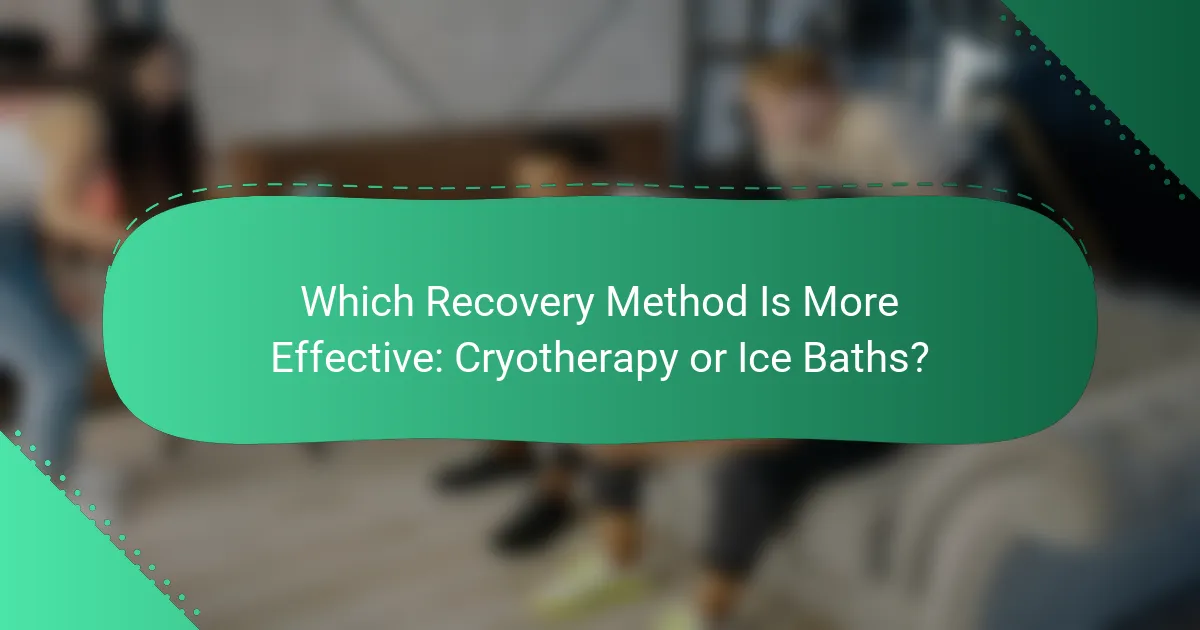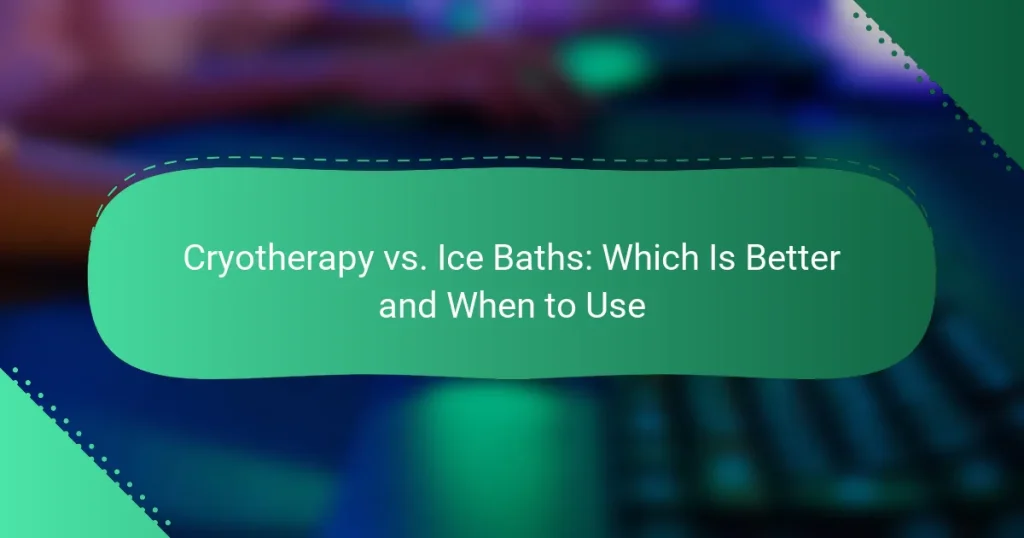Cryotherapy and ice baths are popular recovery methods, each with unique benefits tailored to specific needs. While cryotherapy is effective for rapid inflammation reduction and pain relief, ice baths are often preferred for muscle recovery and managing chronic pain. Understanding when to use each method can enhance recovery and overall performance.

Which Recovery Method Is More Effective: Cryotherapy or Ice Baths?
Cryotherapy and ice baths both serve as effective recovery methods, but their effectiveness can vary based on individual needs and circumstances. Cryotherapy tends to reduce inflammation more rapidly, while ice baths are often favored for muscle recovery.
Cryotherapy reduces inflammation faster
Cryotherapy involves exposing the body to extremely cold temperatures for a short duration, typically between two to four minutes. This rapid cooling can lead to a significant decrease in inflammation and pain, making it a preferred choice for athletes recovering from injuries.
The quick exposure to cold stimulates the body’s natural healing processes, which can help reduce swelling and promote recovery. Many users report feeling immediate relief after a session, making it a popular option for those needing fast results.
Ice baths enhance muscle recovery
Ice baths, or cold water immersion, typically involve sitting in water temperatures around 10-15°C (50-59°F) for about 10 to 20 minutes. This method is effective for reducing muscle soreness and improving recovery after intense workouts.
The cold water constricts blood vessels, which helps to flush out metabolic waste and reduce muscle damage. Athletes often use ice baths post-exercise to enhance their recovery and prepare for subsequent training sessions.
Cryotherapy is more convenient
Cryotherapy sessions can be completed in just a few minutes at specialized clinics or with portable devices at home. This convenience allows for quick recovery without the need for extensive preparation or cleanup.
In contrast, ice baths require a significant time commitment and access to a suitable cold water source. For those with busy schedules, the efficiency of cryotherapy can be a decisive factor in choosing this method over ice baths.
Ice baths are cost-effective
Ice baths are generally more affordable than cryotherapy, as they only require a tub and ice or cold water. This makes them accessible for individuals looking to recover without incurring high costs.
While cryotherapy sessions can range from $30 to $100 each, ice baths can be done at home for minimal expense. This cost-effectiveness makes ice baths a popular choice among recreational athletes and those on a budget.

When Should You Use Cryotherapy?
Cryotherapy is best used immediately after intense physical activity or during the rehabilitation phase of an injury. It helps reduce inflammation and pain, promoting faster recovery and healing.
Post-exercise recovery
Using cryotherapy for post-exercise recovery can significantly aid in reducing muscle soreness and fatigue. Athletes often opt for cryotherapy sessions within 24 hours after intense workouts to minimize delayed onset muscle soreness (DOMS).
Consider a session lasting around 2-3 minutes at temperatures between -110°C to -140°C. This brief exposure can help constrict blood vessels, reducing swelling and inflammation before blood flow returns, aiding recovery.
Injury rehabilitation
Cryotherapy is effective in injury rehabilitation, particularly for sprains, strains, and other soft tissue injuries. It helps manage pain and swelling, allowing for a more comfortable recovery process.
For injuries, sessions can be scheduled several times a week, depending on the severity. Always consult a healthcare professional to tailor the frequency and duration of cryotherapy to your specific needs, ensuring optimal healing without adverse effects.

When Should You Use Ice Baths?
Ice baths are best utilized immediately after intense physical activity or for managing chronic pain. They help reduce inflammation and speed up recovery by constricting blood vessels and numbing soreness.
After intense workouts
Using ice baths after intense workouts can significantly aid in recovery. The cold temperature helps to decrease muscle soreness and inflammation, allowing athletes to bounce back quicker for subsequent training sessions. Aim for a duration of 10 to 15 minutes in water temperatures around 10-15°C (50-59°F) for optimal benefits.
To maximize effectiveness, consider timing your ice bath within 30 minutes post-exercise. This window is crucial as it coincides with the body’s natural inflammatory response, allowing the cold exposure to mitigate swelling and pain effectively.
For chronic pain management
Ice baths can also be beneficial for individuals dealing with chronic pain conditions, such as arthritis or fibromyalgia. The cold exposure can numb the affected areas, providing temporary relief from pain and discomfort. Regular sessions may help in managing symptoms over time.
When using ice baths for chronic pain, start with shorter durations of around 5 to 10 minutes and gradually increase as tolerated. Always consult with a healthcare professional to ensure this method aligns with your specific health needs and conditions.

What Are the Key Differences Between Cryotherapy and Ice Baths?
Cryotherapy and ice baths are both cold therapy methods used for recovery and inflammation reduction, but they differ significantly in their application and effects. Cryotherapy typically involves exposure to extremely low temperatures for a short duration, while ice baths involve immersion in cold water for a longer period.
Temperature exposure duration
Cryotherapy sessions usually last between 2 to 5 minutes, exposing the body to temperatures as low as -110°C to -140°C. This brief exposure aims to stimulate a rapid physiological response, promoting recovery and reducing inflammation.
In contrast, ice baths typically require immersion for about 10 to 20 minutes in water temperatures ranging from 10°C to 15°C. The longer duration allows for a gradual cooling effect, which can help alleviate muscle soreness and improve recovery over time.
Method of application
Cryotherapy is often administered in specialized chambers or localized devices that target specific areas of the body. These machines circulate cold air or nitrogen gas, providing a quick and intense cooling experience.
Ice baths, on the other hand, involve filling a tub with ice and water, where the individual immerses themselves. This method is more accessible, as it can be done at home with minimal equipment, but it requires careful monitoring of water temperature and duration to avoid hypothermia.
Cost and accessibility
Cryotherapy sessions can be relatively expensive, often costing between $30 to $100 per session, depending on the facility and location. Access to cryotherapy may be limited to urban areas with specialized clinics.
Ice baths are much more cost-effective, requiring only a tub, ice, and water. This makes them widely accessible for athletes and individuals looking for recovery options at home. However, the effectiveness can vary based on the setup and individual preferences.

What Are the Benefits of Cryotherapy?
Cryotherapy offers several benefits, primarily focusing on recovery and performance enhancement. It involves exposing the body to extremely cold temperatures, which can lead to improved circulation, increased metabolic rates, and reduced muscle soreness.
Improved blood circulation
Cryotherapy enhances blood circulation by causing blood vessels to constrict and then dilate once the exposure to cold ends. This process promotes better oxygenation and nutrient delivery to tissues, which can aid in recovery and overall health.
For optimal results, sessions typically last between 2 to 4 minutes, allowing the body to experience the cold without excessive discomfort. Regular sessions may lead to noticeable improvements in circulation, especially for athletes or those recovering from injuries.
Enhanced metabolic rate
Exposure to cold temperatures can stimulate the body’s metabolic rate as it works to maintain its core temperature. This increased metabolic activity can lead to more calories burned, which may assist in weight management or fat loss.
Incorporating cryotherapy into a fitness routine can complement other weight loss strategies. However, it’s essential to combine it with a balanced diet and regular exercise for the best results.
Reduced muscle soreness
Cryotherapy is known for its ability to reduce muscle soreness after intense workouts. The cold exposure helps decrease inflammation and speeds up recovery, allowing individuals to return to their training regimens more quickly.
For athletes, using cryotherapy within 24 hours post-exercise can be particularly beneficial. It’s advisable to monitor how your body responds to different durations and frequencies of treatment to find what works best for you.

What Are the Benefits of Ice Baths?
Ice baths offer several benefits, primarily for muscle recovery and reducing inflammation after intense physical activity. They can help alleviate soreness and improve overall recovery times, making them popular among athletes.
Muscle Recovery
Ice baths are effective for muscle recovery as they reduce muscle soreness and inflammation. The cold temperature constricts blood vessels, which helps decrease swelling and tissue breakdown. After exiting the bath, blood flow returns, delivering nutrients to aid recovery.
Inflammation Reduction
By exposing the body to cold, ice baths can significantly lower inflammation levels. This is particularly beneficial after strenuous workouts or injuries, as it helps manage pain and accelerates healing. Regular use can lead to improved performance and reduced risk of injury.
Improved Circulation
Ice baths can enhance circulation by promoting blood flow once the body warms up again. This improved circulation helps deliver oxygen and nutrients to muscles, facilitating quicker recovery. Athletes often incorporate ice baths into their routine to maximize these benefits.
Recommended Duration and Frequency
For optimal results, ice baths should typically last between 10 to 15 minutes. Athletes may use them after intense training sessions or competitions, often 1-3 times a week, depending on their training load and recovery needs.
Considerations and Precautions
While ice baths can be beneficial, they are not suitable for everyone. Individuals with certain medical conditions, such as cardiovascular issues, should consult a healthcare professional before using ice baths. It’s also important to avoid prolonged exposure to prevent frostbite or hypothermia.


